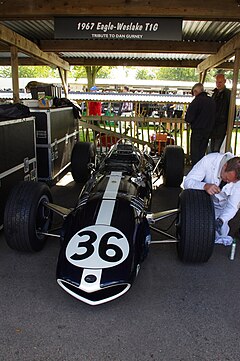Eagle Mk1
 |
|||||||||
| Category | Formula One | ||||||||
|---|---|---|---|---|---|---|---|---|---|
| Constructor | All American Racers | ||||||||
| Designer(s) | Len Terry | ||||||||
| Technical specifications | |||||||||
| Chassis | Aluminium/Titanium-magnesium monocoque | ||||||||
| Suspension (front) | Lower wishbone with single top links. | ||||||||
| Suspension (rear) | As front. | ||||||||
| Axle track | 60 in (1,524 mm) | ||||||||
| Wheelbase | 96.4 in (2,449 mm) | ||||||||
| Engine | Gurney-Weslake Type 58 2,997 cc (182.9 cu in) V12 naturally aspirated, mid-engined, longitudinally mounted | ||||||||
| Transmission | Hewland DG300 5-speed manual | ||||||||
| Fuel | Shell | ||||||||
| Tyres | Goodyear | ||||||||
| Competition history | |||||||||
| Notable entrants | Anglo American Racers | ||||||||
| Notable drivers |
|
||||||||
| Debut |
1966 Belgian Grand Prix, Circuit de Spa-Francorchamps. |
||||||||
|
|||||||||
| n.b. Unless otherwise stated, all data refer to Formula One World Championship Grands Prix only. |
|||||||||
The Eagle Mk1, commonly referred to as the Eagle T1G, was a Formula One racing car, designed by Len Terry for Dan Gurney's Anglo American Racers team. The Eagle, introduced for the start of the 1966 Formula One season, is often regarded as being one of the most beautiful Grand Prix cars ever raced at the top levels of international motorsport. Initially appearing with a 2.7L Coventry Climax inline 4-cylinder engine, the car was designed around a 3.0L Gurney-Weslake V12 which was introduced after its first four races. In the hands of team boss Gurney, the Eagle-Weslake won the 1967 Belgian Grand Prix, making Dan Gurney only the second driver at the time, and one of only three to date, to win a Formula One Grand Prix in a car of their own construction. That win in Belgium still stands as the only Formula One victory for a United States-built car.
A highly successful motor racing driver in many disciplines, Dan Gurney had been driving in Formula One since the late 1950s. While driving for the Brabham works team, he joined with a group of prominent motor racing figures and financial backers in the United States, including Carroll Shelby, to found All American Racers. This effort was largely backed by the Goodyear Tire & Rubber Company, in an effort to challenge Firestone's longtime dominance of American open-wheel racing. Inspired by the performance of Jack Brabham and Bruce McLaren's own teams, AAR decided to enter Grand Prix racing. Then as now, the main engineering hub for Formula One manufacturers was in the United Kingdom, so AAR set up a subsidiary team known as Anglo American Racers which, while registered and based in the USA, was named in deference to the cars' British Weslake engines.
To achieve AAR's dual aims of winning in both Formula One and Champ Car formulae, AAR hired ex-Lotus designer Len Terry to work for the American outfit. His brief was to create a chassis that could be used both for the twisting road course circuits of the F1 series, as well as the broad ovals of the North American series. Terry was ideally placed to be able to fulfill such a brief, having just completed the 1965 Indianapolis 500-winning Lotus 38 for Colin Chapman's team.
...
Wikipedia
